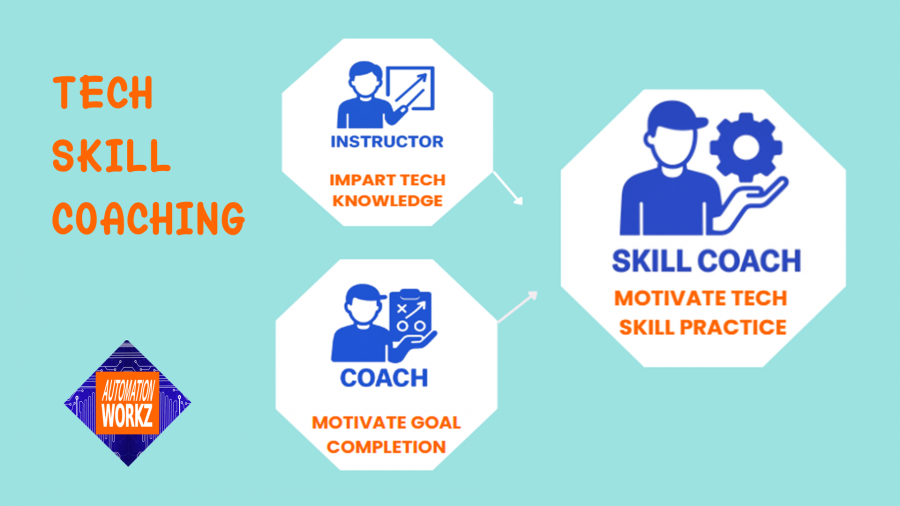Technology
Automation Workz Creates Tech Skill Coaching to Solve the AI Workforce Readiness Crisis – NORTHEAST
Ida Byrd-Hill is CEO, Automation Workz, a workforce transformation firm that provides tech skill coaching to executive leaders and front-liners to increase productivity and profitability. Tech certification specialties are AI & Data Analytics, cybersecurity ops, network engineering, and Internet of Things. While testing its secret weapon, SenseiiWyze, its AI-powered tech skill coach, Automation Workz landed […]

Ida Byrd-Hill is CEO, Automation Workz, a workforce transformation firm that provides tech skill coaching to executive leaders and front-liners to increase productivity and profitability. Tech certification specialties are AI & Data Analytics, cybersecurity ops, network engineering, and Internet of Things. While testing its secret weapon, SenseiiWyze, its AI-powered tech skill coach, Automation Workz landed on the 2022 and 2023 Intelligent.com list of the Top 10 cybersecurity boot camps in the US. It increased front-liner (Call Center, Factory, Logistics, Hospitality, Healthcare and Retail) training completion rates from 7.93% to 75% and average graduate annual salaries from $31,200 to $67,250.
Technology
Apex targets Indian sports assets in Baseline pact
(Philip Brown/Getty Images) Apex Capital, the sports focused investment firm, is eyeing acquisition opportunities in India through a tie-up with local sports marketing firm Baseline Ventures. You’ll need a subscription to continue reading Discover our range of subscription choices, with options starting from £39/month Already have an account? Sign in here Link 0


Apex Capital, the sports focused investment firm, is eyeing acquisition opportunities in India through a tie-up with local sports marketing firm Baseline Ventures.
You’ll need a subscription to continue reading
Discover our range of subscription choices, with options starting from £39/month
Technology
After $300K Kickstarter Success, Omni Health Ring Launches ‘EnerQi™’: The Next-Gen Readiness Score
Omni Health, an emerging health technology company, today announced the launch of the Omni Health Ring smart wearable. Omni Health Ring generates an AI-powered daily plan that works across food, movement, and rest. The plan is personalized to the wearer’s body signals. It is like having a holistic health coach on one’s finger. The company […]

Omni Health, an emerging health technology company, today announced the launch of the Omni Health Ring smart wearable. Omni Health Ring generates an AI-powered daily plan that works across food, movement, and rest. The plan is personalized to the wearer’s body signals. It is like having a holistic health coach on one’s finger. The company is also introducing a new health metric called EnerQi™. This comprehensive, industry-first dynamic health index includes sleep, exercise, stress, nutrition, and real-time updates based on the wearer’s behavior.
The public launch on the company’s official website follows a highly successful Kickstarter campaign this past April, which raised over $300,000 from enthusiastic early adopters. Having already fulfilled and shipped all Kickstarter rewards, Omni Health is now ready to bring its innovative technology to a global audience.
The Omni Health Ring offers a next-gen method for measuring energy as the logical next step to rings that are more about sleep than aspects of daytime performance. Existing wearable rings on the market provide only readiness scores. EnerQi™, in contrast, is a dynamic, multi-dimensional biomarker that updates throughout the day. Its photo-based nutrition tracking offers users the technology to simply snap a photo of a meal and receive an instant macronutrient breakdown with no required manual tracking.
Food awareness is effortless and ties directly into actionable lifestyle planning. The Omni Ring offers comprehensive health planning, rather than just basic data. Omni generates an AI-powered daily plan across food, movement, and rest personalized to your body signals. Omni generates actionable plans when combined with psychological theories like cognitive behavioral therapy (CBT). EnerQi shifts the conversation from “How did you sleep last night?” to “How energized are you right now, and what should you do next?”
“Our story is about solving a fundamental problem because the real goal is daytime energy,” said Jony, the spokesperson for Omni Health. “Many people still feel tired even after sleeping eight hours because factors affecting energy levels are multifaceted. Current wearables focus only on sleep but overlook the combined impact of other factors. This is why we created Omni Health. We created EnerQi™ by fusing the science of the 2017 Nobel Prize-winning research on circadian rhythms with the ancient wisdom of ‘Qi’ (vital energy) to create EnerQi™. We lead the industry by taking passive data tracking and morphing to active health management.”
Jony added, “Reporting from the Omni Ring is not static. Wearers receive a real-time, dynamic, all-day reflection of their body’s vitality. Users become active owners of their health and understand low afternoon energy, response to caffeine or sugar, and insight about activity and nutrition choices for personalized, actionable plans.”
The Omni Health Ring is available for global purchase and shipping. For just $199, you can access features like the EnerQi metric, rivaling trackers that cost over $300.
For more information, visit omnihealthring.com
Technology
Intel’s Unmet Promises | News, Sports, Jobs
It gets a little harder each time to match state officials’ public optimism that Intel will live up to all its promises to Ohioans, when the news is that — again — the company is letting off the gas. In fact, last week Intel said it will “further slow” the pace of construction on a […]

It gets a little harder each time to match state officials’ public optimism that Intel will live up to all its promises to Ohioans, when the news is that — again — the company is letting off the gas.
In fact, last week Intel said it will “further slow” the pace of construction on a microchip facility that was supposed to be up and running THIS year. The last time we got such news, The Columbus Dispatch reported Intel was delaying its opening to at least 2030 or 2031. It is not clear now how much further that date might be pushed.
“While the pace of construction in Ohio may not be as fast, Intel has affirmed its commitment to Ohio as the new leadership of the company makes adjustments to its long-term strategy,” Gov. Mike DeWine recently told the Dispatch.
Intel has already stopped moving forward with planned projects in Germany and Poland, and is planning to cut staffing by 15% in the months ahead, the Dispatch reported.
Remember all the flowery back-patting and cheerleading from public officials crowing about the game-changing impact a company of Intel’s stature would have in inspiring other companies to build here?
It’s time to start speaking in realistic terms to Buckeye State residents and local governments that have become too used to this kind of disappointment. It’s time to start clawing back public money that did not buy us what we hoped it would.
Intel has no qualms about going back on its word. The DeWine administration, the Ohio Department of Development and JobsOhio must not go back on theirs.
Technology
New fitness center in Kentucky offers a gentle approach to exercise
COVINGTON, Ky. (WKRC) – A new fitness trend is taking root in Northern Kentucky, offering a kinder, gentler approach to exercise. The Track, a women’s workout center, is utilizing infrared light to stimulate muscles, circulation, and recovery, while promoting a philosophy of listening to one’s body. Taylor Reams, owner and fitness instructor at The Track, […]

COVINGTON, Ky. (WKRC) – A new fitness trend is taking root in Northern Kentucky, offering a kinder, gentler approach to exercise.
The Track, a women’s workout center, is utilizing infrared light to stimulate muscles, circulation, and recovery, while promoting a philosophy of listening to one’s body.
Taylor Reams, owner and fitness instructor at The Track, emphasized the importance of tuning into personal energy levels and body cycles.
“What we are really here to do is tell women to listen to their bodies,” Reams said.
Her workouts incorporate a concept known as “cycle syncing,” allowing women to move regardless of their energy levels or time of the month.
“We wanted to create something for women that they still could move, no matter what part of the month they are in – but also even with life, like sometimes you are just low on energy,” she added.
Unlike traditional hot exercise classes, The Track uses infrared light panels to create a dry warmth, which Reams explained is “really just there to open you up a little bit more.” Participants have noticed the benefits.
Josie Shriver, a class participant, said, “I did notice a difference with my body and the way that I was moving.”
Another participant, Gabrielle Gardner, known as “Gigi,” described the workouts as “something completely different than I’ve ever done.”
The classes blend yoga and Pilates-inspired moves, which Perlica Piccirillo, another participant, found effective.
“When I come out of here I’m like dang, I really worked my core and I feel amazing,” Piccirillo said.
The Track offers both individual fitness classes and monthly memberships ranging from $15 to $100. For more information, visit their website.
Technology
W.Va. needs to increase efforts | News, Sports, Jobs
Since the start of his term, Gov. Patrick Morrisey has promoted an “Economic Backyard Brawl” between West Virginia and its neighboring states. The mission, he said, is to make the Mountain State “the most attractive state to live, work, learn, play and run a business.” He likely didn’t expect one of those neighboring […]

Since the start of his term, Gov. Patrick Morrisey has promoted an “Economic Backyard Brawl” between West Virginia and its neighboring states. The mission, he said, is to make the Mountain State “the most attractive state to live, work, learn, play and run a business.”
He likely didn’t expect one of those neighboring states to take the opening kickoff and run it back 90 yards for a touchdown.
President Donald Trump recently visited Pittsburgh to announce more than $90 billion in new investments in energy and artificial intelligence in Pennsylvania. Nearly two dozen technology and energy companies will invest in the Keystone State to establish a new artificial intelligence economy.
All of a sudden, West Virginia is looking at the scoreboard and not liking what it sees.
What West Virginia and the Morrisey administration see is reality — this state has plenty of work to do to become truly competitive with neighbors like Pennsylvania, Virginia, Maryland, Kentucky and Ohio. Some of the foundation already has been laid. Morrisey signed into law a bill allowing people moving to West Virginia to transfer their occupational licenses. A one-stop-shop portal is on its way to streamline the licensing and permitting process. The Grow West Virginia Initiative has put aside $50 million in discretionary state funds for targeted investments in economic development. A couple of six-figure announcements already have been made.
Residents of the Mountain State can’t look down their noses at progress, but when you look at West Virginia investing a few hundred thousand dollars in a business compared to the multi-billion-dollar announcement in Pennsylvania, there really is no comparison.
Any good college coach will tell you, in the recruiting game, the recruits “buy with their eyes.” They inspect what’s in front of them and, if it’s impressive enough, they’ll commit on the spot. If your team’s facilities aren’t as shiny and new, if your campus isn’t as welcoming, they’ll move along to somewhere else.
The tech and energy companies investing in Pennsylvania looked around and decided that state was worth billions. West Virginia needs to get on the fast track to becoming that attractive, or we will continue to watch our neighbors reap rewards.
Morrisey and the West Virginia Legislature need to make bold moves to gain ground on these other states. And need to be forward-looking when drawing up that playbook, rather than ripping pages out of “The Way Things Used To Be.” Those moves must not only make it more attractive economically for big businesses to move in, but more attractive for their employees to want to move with them.
Many of the most desirable companies employ a diverse group of people. Some of those people, looking at recently passed legislation, may believe they wouldn’t feel welcomed in West Virginia. If too many employees feel that way, those big businesses will cast their eyes elsewhere.
West Virginia’s “Economic Backyard Brawl” is barely into the first quarter. There’s plenty of game to go. The Mountain State will need some big plays, though, to catch up.
It can’t wait, or else it could see that score get a lot worse.
Technology
Fitbit Charge 6 gets new faces & gym support, other models see fixes
Fitbit has been unusually quiet in 2025. No new devices, barely a word from the team, and firmware updates have been few and far between. But now there’s finally something to talk about. Charge 6 gets fresh clock faces and broader gym equipment support and there are bug fixes to Versa 4, Sense 2 and […]

Fitbit has been unusually quiet in 2025. No new devices, barely a word from the team, and firmware updates have been few and far between. But now there’s finally something to talk about. Charge 6 gets fresh clock faces and broader gym equipment support and there are bug fixes to Versa 4, Sense 2 and Inspire 3.
Charge 6 gets new faces and gym upgrades
Firmware update 220.21 is rolling out now to Charge 6 owners, and while it won’t change how you use the tracker overnight, it does give the device a bit more character. The highlight is a trio of new clock faces: Axira, Geometric and Momentum. They’re built to show more data directly on the home screen and to let users jump into core stats without diving through layers of menus.

Also included in the update is a boost to how the Charge 6 connects with fitness equipment. The device could already share your real-time heart rate with some treadmills and bikes, but this update expands the list of compatible gear.
Versa 4, Sense 2 and Inspire 3 get bug fixes
The new firmware doesn’t stop with Charge 6. Fitbit has also slipped in some fixes for other models, including the Versa 4, Sense 2 and Inspire 3. These aren’t feature updates, and Fitbit hasn’t gone into detail, just noting that the changes are “general bug fixes and improvements.” Still, it’s the first firmware movement in a while for these devices, so it’s worth checking if your watch is ready to update.
Essential reading: Top fitness trackers and health gadgets
So far there’s no sign of bigger changes to the UI or any other ground-breaking new features. That said, the fact that Fitbit is still pushing updates at all is mildly encouraging, especially in a year where the brand has said almost nothing.
We are still hopeful the Charge 7 might land soon. Perhaps at the tail end of August, ahead of IFA in Berlin. That will mark nearly two years since the Charge 6 was released. The company typically announces a new version every other year.
Subscribe to our monthly newsletter! Check out our YouTube channel.
-

 Fashion2 weeks ago
Fashion2 weeks agoEA Sports College Football 26 review – They got us in the first half, not gonna lie
-

 Health2 weeks ago
Health2 weeks agoCAREGD Trademark Hits the Streets for Mental Health Month
-

 Sports2 weeks ago
Sports2 weeks agoVolleyball Releases 2025 Schedule – Niagara University Athletics
-

 Youtube3 weeks ago
Youtube3 weeks agoWill Giannis DEPART Milwaukee⁉️ + How signing Turner & waiving Dame impacts the Bucks | NBA Today
-

 Sports2 weeks ago
Sports2 weeks agoNew NCAA historical database provides wealth of information on championships
-

 Sports2 weeks ago
Sports2 weeks agoAdapti, Inc. (OTC
-

 College Sports2 weeks ago
College Sports2 weeks agoBuford DB Tyriq Green Commits to Georgia
-

 Youtube3 weeks ago
Youtube3 weeks agoThe Twins squeeze out a walk-off win 👀
-

 High School Sports5 days ago
High School Sports5 days ago100 days to men's college basketball
-

 Youtube3 weeks ago
Youtube3 weeks agoIt’s almost time 🎮🔥






























